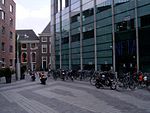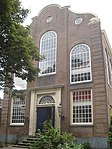Portuguese Synagogue (Amsterdam)
1675 establishments in the Dutch Republic17th-century synagoguesJewish Dutch historyJudaism in AmsterdamOrthodox Judaism in the Netherlands ... and 9 more
Orthodox synagoguesPortuguese-Jewish diaspora in EuropeReligion in the Dutch RepublicReligious buildings and structures completed in 1675Rijksmonuments in AmsterdamSephardi Jewish culture in the NetherlandsSephardi synagoguesSpanish-Jewish diaspora in EuropeSynagogues in the Netherlands

The Portuguese Synagogue, also known as the Esnoga, or Snoge, is a late 17th-century Sephardic synagogue in Amsterdam, completed in 1675. Esnoga is the word for synagogue in Judaeo-Spanish, the traditional Judaeo-Spanish language of Sephardi Jews. The Amsterdam Sephardic community was one of the largest and richest Jewish communities in Europe during the Dutch Golden Age, and their very large synagogue reflected this. The synagogue remains an active place of worship and is also a popular tourist attraction.
Excerpt from the Wikipedia article Portuguese Synagogue (Amsterdam) (License: CC BY-SA 3.0, Authors, Images).Portuguese Synagogue (Amsterdam)
Jonas Daniël Meijerplein, Amsterdam Centrum
Geographical coordinates (GPS) Address Nearby Places Show on map
Geographical coordinates (GPS)
| Latitude | Longitude |
|---|---|
| N 52.3675 ° | E 4.9054 ° |
Address
Portugese Synagoge
Jonas Daniël Meijerplein
1011 RG Amsterdam, Centrum
North Holland, Netherlands
Open on Google Maps











